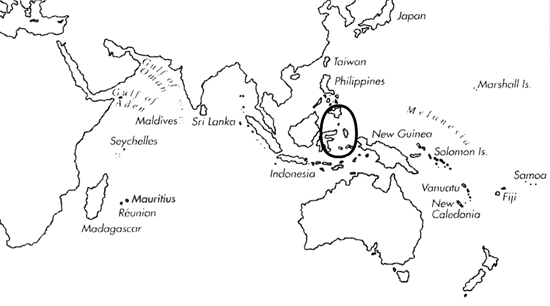
Skip Navigation Links
View access keys for this site.

Range: Moluccas, Sulawesi, and Philippines south of Mindanao.
Description: Medium-sized to large, solid. Last whorl ventricosely conical or conical; outline convex at adapical fourth, almost straight below. Shoulder sharply angulate. Spire usually of moderate height, outline straight to convex, apex domed. Larval shell of about 2.5 whorls, maximum diameter 0.7-0.8 mm. First 4-6 postnuclear whorls tuberculate. Teleoconch sutural ramps concave, to deeply concave in late whorls, with 3-4 increasing to 5-8 sometimes weak spiral grooves. Last whorl with rather evenly spaced spiral ribs on basal third, or extending to adapical part.
| Shell Morphometry | ||
|---|---|---|
| L | 45-95 mm | |
| RW | 0.24-0.46 g/mm | |
| RD | 0.57-0.62 | |
| PMD | 0.81-0.87 | |
| RSH | 0.10-0.16 | |
Ground colour white, variably suffused with pink. Last whorl usually with 2-3 variably broad, pinkish brown spiral bands. Spiral rows of alternating white dashes and reddish to blackish brown dots, dashes and bars from base to shoulder; rows variable in size and number of brown markings. Base yellow. Apex immaculate white. Late sutural ramps largely light pinkish violet, usually with sparse brown blotches, occasionally with sparse white blotches; outer and inner margins of late sutural ramps barred with blackish brown. Aperture white or pale pink.
Periostracum pale yellow, thin, translucent, smooth.
Radular teeth reported to be relatively long (shell/tooth-ratio 11:1), with 2 small barbs and a long backward-pointing, distally recurved third barb at the apex; neither serration nor basal spur present (James, 1980).
Habitat and Habits: In 20-80 m; Cernohorsky (1978) reports an intertidal occurrence. Structure of radular teeth suggests piscivory.
Discussion: C. aurisiacus closely resembles C. circumcisus, which can be distinguished by its distinctly narrower (RD 0.44-0.57) and more cylindrical last whorl, its subangulate to rounded rather than sharply angulate shoulder and by its less concave sutural ramps with a less pronounced spiral sculpture.

C. aurisiacus range map
This section contains verbatim reproductions of the accounts of 316 species of Conus from the Indo-Pacific region, from Manual of the Living Conidae, by Röckel, Korn and Kohn (1995). They are reproduced with the kind permission of the present publisher, Conchbooks.
All plates and figures referred to in the text are also in Röckel, Korn & Kohn, 1995. Manual of the Living Conidae Vol. 1: Indo-Pacific Region.
The range maps have been modified so that each species account has it own map, rather than one map that showed the ranges of several species in the original work. This was necessary because each species account is on a separate page on the website and not confined to the order of accounts in the book.
Return to framed version (returns to search page)